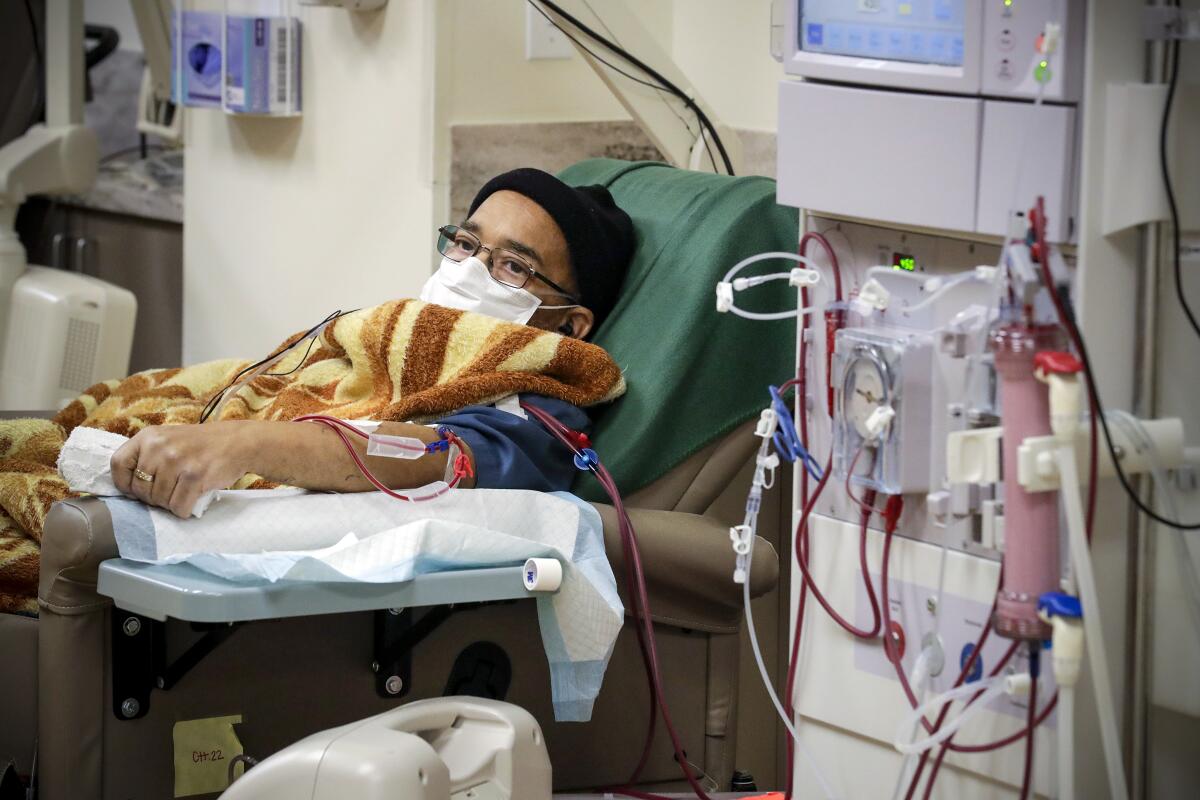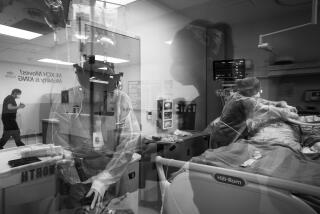What COVID-19 patients young and old can teach us about the coronavirus

- Share via
They’re the cases that stand out, because they don’t seem to fit the coronavirus pattern: A 32-year-old nurse died of COVID-19 after spending several days on a ventilator at Harbor-UCLA Medical Center. A 25-year-old pharmacy technician who had seemed to be in good health had succumbed to COVID-19 in a Riverside County home.
It’s enough to make you wonder: Is the coronavirus more dangerous to younger people than scientists initially thought?
When the outbreak took off in Wuhan, China, there was a distinct trend: The older the patient, the greater the risk of death. And as the virus spread around the world, that trend seemed to hold up. A study published in the medical journal Lancet that analyzed more than 70,000 cases from January and February found that the fatality rate for COVID-19 patients in their 30s was 0.15%, compared with 13.4% for those 80 and older.
But in the U.S., doctors on the front lines have noted strange and often alarming conditions in younger victims, including patients in their 30s and 40s dying of strokes after experiencing only mild COVID-19 symptoms. Children and teens have ended up in hospital intensive care units with symptoms of a rare inflammatory syndrome called Kawasaki disease that could be related to COVID-19, according to a bulletin released by the New York City Health Department this week.
For now, cases like these remain disparate pieces of a much larger puzzle. As scientists dig deeper, they hope to learn more about the role of age as a COVID-19 risk factor and why the disease is so dangerous to the elderly.
But in the meantime, they’re seeing that younger victims are still more the exception than the rule, even in the U.S. Here’s a closer look at what they know so far, and what they’re still trying to find out.
Age is a factor in deaths, but not in infections
Scientists generally agree that when it comes to age, the coronavirus doesn’t appear to discriminate, though pinning down the infection rate will require far more widespread testing than has been done so far.
“Anyone at any age can become infected,” said Dr. Timothy Brewer, an infectious disease specialist and epidemiologist at UCLA. “But we are seeing very different outcomes in what happens after people are infected.”
As the pandemic has grown, the risk of ending up in the hospital or dying has remained markedly higher for those in older age groups — a trend that’s become even clearer over time.
Soon after the Centers for Disease Control and Prevention began monitoring the coronavirus’ activity in the U.S., it found that for the week ending March 21, the COVID-19 hospitalization rate for those 65 and older was 10.4 per 100,000 people, compared with 1.9 hospitalizations per 100,000 people ages 18 to 49. By May 2, both figures had risen considerably — to 162.2 hospitalizations per 100,000 senior citizens and 26.2 per 100,000 younger adults — but the large gap remained.
COVID-19 hospitalization rates are lower in California, but they follow the same trend. The most recent figures from the CDC’s COVID-NET surveillance network indicate that 56.9 out of every 100,000 Californians 65 and up had been hospitalized for COVID-19, compared with 10.9 out of every 100,000 Californians ages 18 to 49.
In many infectious disease outbreaks, such as seasonal influenza, the very young and the very old face the greatest risk of serious illness and death. Researchers are still puzzled as to why COVID-19’s pattern is so one-sided, with infected children typically having only mild symptoms of the disease.
One potential explanation is that the immune systems of children are too immature to trigger the massive inflammatory response that can lead to septic shock, organ failure and other complications in some COVID-19 patients, experts say.
Another hypothesis is that there are so many other types of mild coronaviruses circulating among children that they have some kind of partial immunity against the SARS-CoV-2 coronavirus, the one that causes COVID-19.
But Brewer said that so far, there’s no solid evidence that that’s the case. If it were, he said, the virus wouldn’t be spreading about as easily among children as it has in older adults.
“This virus is basically spreading like a virus that has a susceptible population.” Brewer said. “For the age difference, yes, I think there’s some other explanation.”
Once found, he added, it may “give us important insights into what’s going on with this virus.”
The course of a country’s outbreak depends on the age of its population
The progression of the outbreak and the toll it takes has varied from country to country, said Jennifer Beam Dowd, a demographer and social epidemiologist at Oxford University. That’s due to a wide variety of factors, from the intensity of testing to the timing of lockdown orders and the way the disease first entered a country.
One key factor is the age structure of the population — how many people are old, how many are young and how many fill the categories in between.
Take Italy, a country of just over 60 million people that has suffered close to 30,000 deaths so far (compared to just over 4,600 deaths in China, home to 1.4 billion people).
The odds may have been stacked against Italy because its population skews older: An estimated 23% of its citizens are 65 or older, according to United Nations world population data. In China, by contrast, just 12% of citizens are seniors (and in the U.S., it’s almost 17%). With COVID-19, assuming that all ages get infected at a similar rate, an older population is likely to mean more deaths, and that seems to have held up in Italy, where more than 95% of deaths were in patients 60 and up, according to data from Italy’s COVID-19 surveillance group.
In a study published in the Proceedings of the National Academy of Sciences, Dowd and her colleagues used models to explore how countries with similarly sized populations but different age structures would fare in a coronavirus outbreak. Assuming a constant infection rate and using the age-specific death rates seen in Italy, they predicted that Brazil, where 2% of the population is at least 80, would have three times as many deaths as Nigeria, where only 0.2% of the population is over 80. (Brazil has about 210 million residents, only slightly more than Nigeria’s 196 million.)
The interactions between people in different age groups may also play a role in who lives and who dies, Dowd said. For example, in Italy, older adults are more likely to live with their adult children than in other countries — and even if they don’t, they often live close enough to share meals on a regular basis, Dowd’s Italian colleagues told her.
There appear to be fewer such points of intergenerational contact in Germany, and the death toll there has been significantly lower: around 7,400 fatalities so far out of more than 169,000 cases. (This despite the fact that Germany’s population is about one-third larger than Italy’s.)
“We do think that could be one of the important differences,” Dowd said.
In many countries, the coronavirus seems to have circulated undetected among younger people before making the jump to older people and causing enough serious illnesses and deaths to gain notice. That’s a problem, because it may be giving the virus a chance to quietly solidify its beachhead. But if an outbreak can be identified while it’s still contained in that younger, less vulnerable population, a separation between generations could serve as a protective buffer.
Strong social ties between generations are a very healthy phenomenon in normal circumstances, Dowd said. But in pandemics, “it could be that it puts that [older] population at risk.”
Age considerations may inform the way authorities mitigate disease transmission not just across international borders but also between local areas with very different social and population structures, she said.
When it comes to rolling out more widespread, systemic testing, “it might be that we really want to target people in living situations that are most at risk,” she said.
What does ‘age’ really mean?
On a very basic level, age is essentially a decline in the body’s ability to regenerate, Brewer said.
“We can no longer repair ourselves and our cells at a rate that we can when we’re younger,” he said. “Not only does that affect things like our bones and our hearts, it affects our immune system as well.”
It could be that older people’s bodies are simply less capable of handling the virus. But that declining function often comes with a host of common chronic conditions, such as cardiovascular disease, diabetes and hypertension, and these could put a COVID-19 patient at greater risk of serious illness or death, regardless of their age, said Dr. Kirsten Bibbins-Domingo, chair of epidemiology and biostatistics at UC San Francisco.
“It’s hard to disentangle the two,” she said. “You don’t know whether it’s the heart disease — or it’s being old.”
For instance, people under 60 make up a larger share of COVID-19 deaths in the U.S. than they do in Europe, Bibbins-Domingo pointed out, and “it may be that we have more people who have heart disease at younger ages than they do in these other places.”
Separating these factors is an important step in tackling the disease, scientists said. That’s because many of those chronic health conditions are more prevalent in minority and underprivileged communities.
In fact, if a region’s hospitalized COVID-19 patients skew slightly younger than expected, it might be a sign to look for these health disparities, Dowd said.
“That probably is an interesting part of the story here,” she said.
A Times analysis found that younger black and Latino Californians are dying of COVID-19 at higher rates than their white and Asian peers. That pattern is repeating itself across state boundaries, public health data shows.
“We often talk about it as accelerated aging,” Dowd said. Deeply disadvantaged people in their 40s might have the same biological profile as more privileged people in their 60s, for example, “so that’s kind of an interesting lens with which to think about this.”
In that way, COVID-19 is bringing the country’s racial and socioeconomic health disparities into sharp focus, scientists said.
So does the coronavirus’s particular toll on older patients muddy these issues — or help clarify them?
“The answer is both,” Brewer said.
What more detailed age data might reveal
A big unknown is which age groups are spreading the virus the most, said Dr. Theo Vos, an epidemiologist at the University of Washington. Figuring that out could help health officials decide when certain institutions, such as schools and colleges, can safely reopen.
Finding the answer will require more aggressive contact tracing (to identify patterns in disease transmission) and far more widespread antibody testing (to identify people who were infected without realizing it). It’s likely that many younger people who had the disease have gone uncounted because their symptoms were mild, Vos said. Tracing and testing would address that.
In the U.S. and many other countries, scientists will also need more refined age data on COVID-19 patients, Dowd said. Sometimes age brackets are narrow (65 to 74) and sometimes they span several decades (18 to 49). Differences between younger adults and those in midlife are hard to see when they’re all lumped together. Smaller age brackets would also make it easier to combine data from different jurisdictions, whose current brackets often aren’t a perfect match.
Luckily, scientists are already collaborating to assemble age and other demographic information on COVID-19 patients from many different countries.







